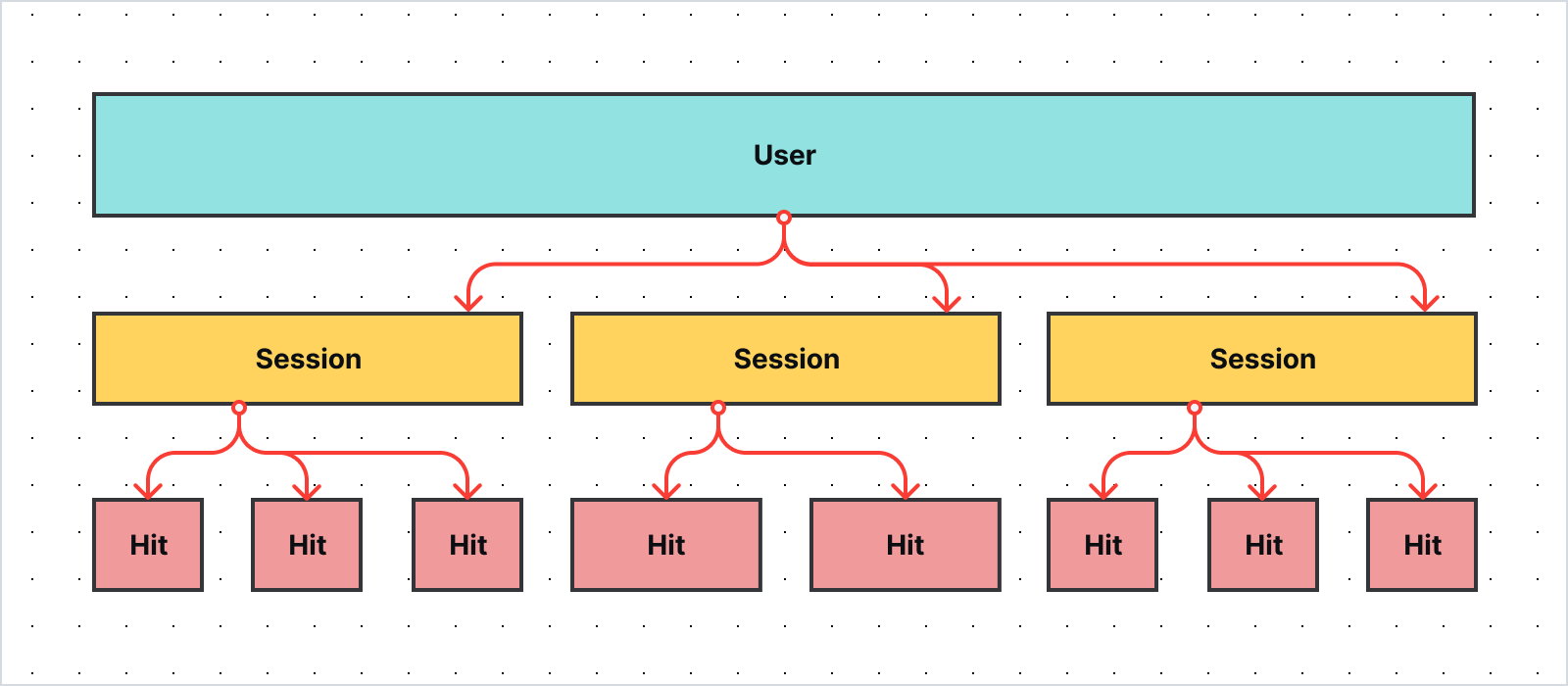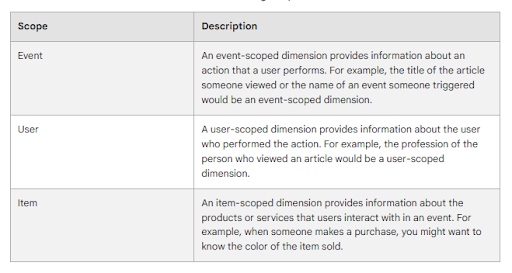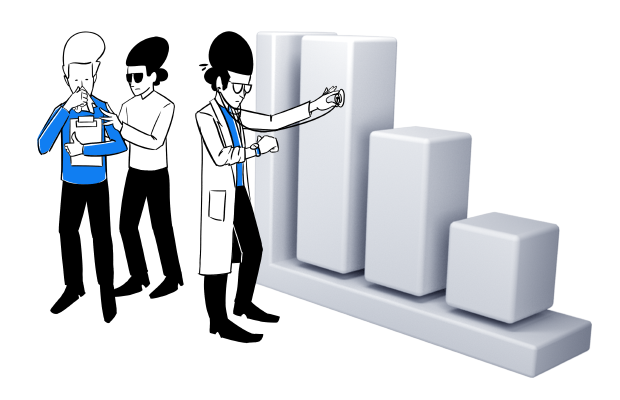On July 1, 2023, Google sunsetted Universal Analytics (UA) and replaced it with its next-generation measurement tool, Google Analytics 4 (GA4). That means that standard UA properties have stopped processing new hits.
You’ve probably heard that the GA4 is the future of analytics, and session-based analytics is a thing of the past.
This article challenges this belief and discusses scopes in analytics. It also presents use cases for which the session-based model might be better than the new system.
Session vs. event
Both Universal Analytics (a session-based platform) and Google Analytics 4 (an event-based platform) operate on events and sessions, but they’re set up and counted differently.
A session-based analytics platform uses sessions as the foundation of all reporting. A session refers to various interactions within a given timeframe (typically 30 minutes). Think of a session as a container for all user actions on your site.
Platforms like Universal Analytics also allow you to track specific events within your page, such as button clicks or scrolls. However, you must set them up first.
Event-based data measurement models provide a more user-centric view of data beyond tracking sessions and page views. While page views, user timing, and app/screen views are classified as hit types in session-based analytics, they’re all counted as events here. In GA4, a session is a number of “session_start” events. Session calculation is done client-side. In UA, session calculation is done on the server during processing. Events (called hits) that belong to the same session can be grouped via session-scoped segments. GA4 does not have that scope as it does not group events belonging to the same session.
If you are interested in the differences between session-based and event-based analytics, read more: Universal Analytics vs. Google Analytics 4: Data models and other key differences explained
Scopes in analytics
We explain scopes as they are important for you to understand the difference between the two analytics methods.
The scope is how an analytics platform collects and formats the data it receives. Scopes significantly impact how your analytics data is structured and what you end up working with. Let’s see how scopes work in session-based and event-based analytics.
There are four ways in which analytics platforms like Universal Analytics “scope” dimensions and metrics:
- User — It looks at data regarding a user’s aggregated sessions and hits (hit is an event, page view, etc.). It allows you to see the user’s entire journey.
- Session — Groups hits throughout the session. This will attribute full “session” from when a user enters the site until they leave, with all subsequent hits within it.
- Hit (event) — It captures each view or interaction on the site to understand user behavior better.
- Product — The product scope is specifically for ecommerce use. It shows behavior by specific products, like product transactions or product revenue.
You can experience the rules of scope when you create custom reports. As each dimension and metric has a scope (user-level, session-level, hit-level), you can’t combine the dimensions and metrics of different scopes.
Scopes make up a hierarchical structure – hits ladder up to sessions, and sessions ladder up to users. Think of scope in Universal Analytics as a way to understand a journey, your data’s road trip.

In Google Analytics 4, scope refers to how custom dimensions are defined. It also guides how Google Analytics should collect and organize data.
For custom dimensions, there are three types of scopes:
- Event-scoped custom dimensions
- User-scoped custom dimensions
- Item-scoped custom dimensions

GA4 does not have hit and session scopes – hit was replaced by the event scope and there is no session scope. And a custom metric always has an event scope.

Due to differences in measurement models and scopes, the session count differs between the two types of analytics platforms.
You may also like:
Event-based web analytics: Everything you need to know
Why do sessions remain the most reliable measurement unit?
Session-scoped data is not an ideal measurement time frame because people can stop in the middle of buying and return to purchase in what is technically a new session. Consider this: when does this time frame end if the user cannot find what they want, abandons the shop, and then returns to order something completely unrelated? In this scenario, we would combine their unsuccessful purchase journey with their next one for something else. As you see, arbitrary divisions are never universal solutions.
Working with user-scoped data might mean using a very long time frame of everything a user has done from the first interaction with your page. Take the example of a website selling concert tickets. Users can find your website when searching for concert tickets but leave without purchasing. However, after many return visits and considering their funds and competing ticket prices, they finally buy their tickets. At that point, this user may return to your site to check out other concerts. All data points collected about this user will be user-scoped throughout their lifetime on your site.
Limiting this time frame to “until the next purchase” might be helpful, but it still combines people’s uncompleted purchases with completed ones, thus skewing your data. People also use different devices and browsers, which might introduce bias.
There is also a privacy angle. User scope is not privacy-friendly. Despite some changes in privacy settings, Google Analytics 4 still collects personal data (unique user identifiers). In contrast, with session scope you can do useful analytics without personal data using anonymous tracking. In this case, the analytics platform deploys a session identifier as a cookie that collects session data without personal data. After 30 minutes (the duration of a session) it removes the identifier from the web browser.
Experts opinion
“Some claim that we have progressed from session-focused analytics to user-focused analytics. But that is a misconception.
Users can have different intentions when visiting your site (for example, buying clothes, learning about offers, contacting customer service). So in an ideal world, we could analyze user behavior within such time frames of intent, but that is challenging or impossible to accomplish with any tool. So the session scope remains our closest guess to the time frame of intent in most cases.
Moreover, in a world of many devices, browser restrictions, and privacy regulations, the session is the only unit that can be measured consistently everywhere.”
Let’s dive deeper and examine some use cases.
Session-based analytics use cases
Since the event-based model gives you customer-centric measurement based on data from multiple touchpoints, it can offer a fuller picture of the buyer funnel – especially if multiple steps in a conversion funnel can be completed over separate visits. But if you are a marketing professional, sessions will continue having some crucial use cases. Here are some examples:
1. Omnichannel marketing
Session-based analytics is essential for omnichannel marketing, which involves multiple touchpoints with different sources and channels (each session will have an assigned channel/source through which the user entered the site). Here, it’s impossible to escape the concept of a session. After all, a session is an aggregate, and using aggregates significantly saves time and resources.
Session-based data models offer a rich set of built-in reports, like acquisition reports, from which you can get data and insights into how people find your website. This makes them simple and accessible, handy for professionals who aren’t deeply immersed in analytics.
2. User journey analytics
Ecommerce
Let’s say you have an online retail shop with various products from different categories and regular clients. You want to report on their interactions with your assortment.
A client visits your site and buys a product from the food products category. A few days later, they return to search for a product from the household goods category but can’t find anything that suits them and leave. The same user performed both visits. However, you need to look at each visit separately, as they present different journeys and intents.
You can count every hit (available in GA4). You can also count once per session (UA doesn’t offer that for ecommerce, but it is possible for goals) or once per user.
The session scope might be more accurate in this case. The hit scope is too broad, as it counts each reload and every back-and-forth of indecisive users. If you want to know which category gets the most traffic, you should focus on the session scope.
On the other hand, the user scope is too limited, especially when looking at conversion reports. It only allows conversions based on events, meaning any page view goals need to be sent as an event to GA4 before they can be tracked as a conversion.
High-value pages or successful form submission
If your form, after submission, leads to a “thank you” page or similar, there’s a good chance you had goals set for them in Universal Analytics. In this case, it is also difficult to escape from the concept of a session. You can report and analyze the conversion rate of each traffic source for each goal. You may use the “end session” point to analyze and optimize the conversion rate.
For example, the Goal URLs report shows you the URLs where most goals are completed. This report will often display the URL you assigned as the goal completion point (for example, a sign-up form for the “thank you” page). And if you’re using events to set goals, this report becomes even more helpful, as it reveals which website elements help achieve the highest conversions. With the code implemented on every website page, you can collect data on button clicks, links, social media profiles, and more.
GA4 conversions are different. Goals as conversions are not URL-based. For example, you can’t use the “end session” point as in UA since, in event-based analytics, it’s hard to locate actual drop-offs without sessions. All conversions are events. To set an event as a conversion, you will have to mark it as a conversion in existing events. Since conversions are based solely on events, you need tools like Google Tag Manager.
When you need to track visits to high-value pages or successful form submissions easily, events present another major challenge. They are only useful from the date when you first implemented them. If you want to analyze how someone has progressed through your funnel, you won’t have data from the beginning of your product’s history. While some platforms support historical backfilling, such processes come at a significant cost in terms of price and engineering time.
3. Accurate data and data control
Browsers treat cookies differently. Safari deletes your regular JS cookie after 7 days. In Chrome, cookies last up to 400 days. Yet, even if endless cookies are everywhere, we live in a world of multiple devices. This is where the same user can quickly perform a session on many different hardware and browsers. While some businesses can afford to tie each or at least most of those devices to the same user, that is an exception.
Because session scope is resistant to short cookie lifespan, your data is more accurate and reliable.
In order to compensate for ditching third-party cookies, GA4 relies more heavily on sampled data and machine learning. It uses machine learning to model missing analytics from users who do not consent to cookies. This may lead to inaccuracies in reporting, especially if you need detailed segmentation. Data sampling also adds guesswork to your reports, meaning you can’t be 100% sure of data accuracy.
In addition, privacy frameworks like GDPR scrutinize adhesive identifiers for users. The interpretation of GDPR by France’s CNIL allows some analytics tools if they limit tracking to session cookies only. Due to the proliferation of devices, browser restrictions, and privacy regulations, sessions are increasingly becoming the only reliable unit of measurement. In other words, data focused on users has become ever more inaccurate.
Considering all of the above, the claim that user-centric analytics based on events is the future of analytics might be far-fetched. Both kinds of analytics have their use cases.
Final thoughts on users vs. sessions
So, is session-based analytics dead? We are far from that. Despite popular belief, sessions are still essential in many circumstances. This will continue to be the case for the foreseeable future.
Measuring marketing performance
Session-based analytics allows you to report easily on your marketing channels’ performance. Traffic acquisition reports are especially helpful in understanding how traffic sources perform regarding total sessions on the site and driving conversions. The Source/Medium report allows you to understand the performance of various traffic sources and mediums. You can also find referrals under Acquisition in the All Traffic, and All Referrals reports. Finally, you can use the information on the “start session” point (where the user found the website) to optimize marketing campaigns.
Ease of use
User-centric analytics platforms based on events like GA4 are built more as tools for collecting lots of data, with much of the analysis taking place outside the platform. Analyzing your funnel can be challenging as you might have to combine data from different sources. You should look at your product data or data warehouse for the full picture. This might be effective for some, but many people working with data might feel overwhelmed by the task.
There is also a steeper learning curve involved. These platforms are more difficult to work with if you’re not a seasoned analyst. Getting some metrics and dimensions with event-based analytics is harder. Even though all the data is available, professional web analysts using the raw data might need help creating advanced queries to generate reports based on session data tracked as an event.
To sum up: Becoming user-centric is challenging due to the range of platforms and devices, the need for specific teams and analytics tools, and the difficulty in centralizing the data structure. Yet, user-oriented analytics can be helpful for product managers, as data visualization options and capabilities, for example, in GA4, are well suited to product analytics. But if you are a marketer, session-oriented analytics is the best solution to perform accurate website analytics that helps improve marketing decisions in order to get better ROI.
What’s the alternative?
There are modern platforms that handle sessions and events seamlessly if you need an alternative to the user-centric GA4. They allow you to use all events in your advanced reports, such as funnels and user flows. But at the same time, they give you the option to take advantage of the session-level aggregation and dimensions you know from classic session-based analytics.
On top of that, some platforms, like Piwik PRO, are built with privacy in mind. They have an integrated Consent Manager that makes it easy to comply with laws such as GDPR or TTDSG/TDDDG.
You may also like to have complete control over the data you collect. That, combined with flexible data hosting, allows you to employ analytics in more contexts without violating user privacy. This is something you must focus on in today’s world, where the efficiency of data collection must be balanced with security and data protection.
See product comparisons to help you choose the right web analytics software. We present the essential features of all products, explaining in detail their characteristics from a legal, technical, and practical point of view:
If you’d like to learn more about a privacy-friendly, session-based analytics platform, be sure to contact us. We’ll be happy to answer all your questions.











